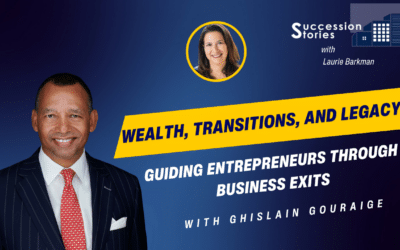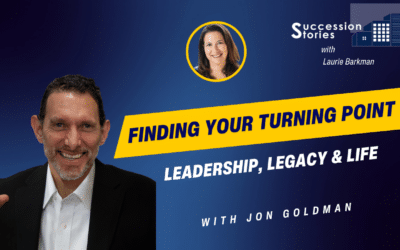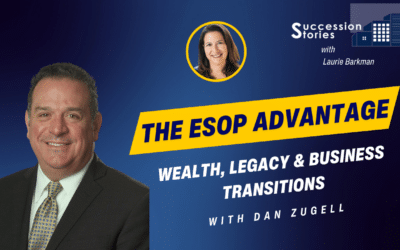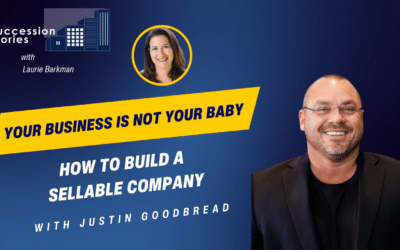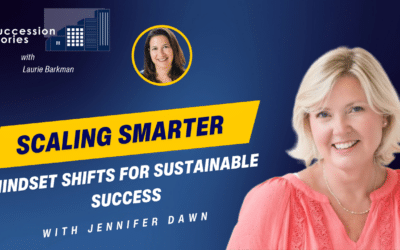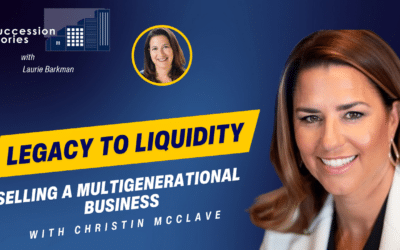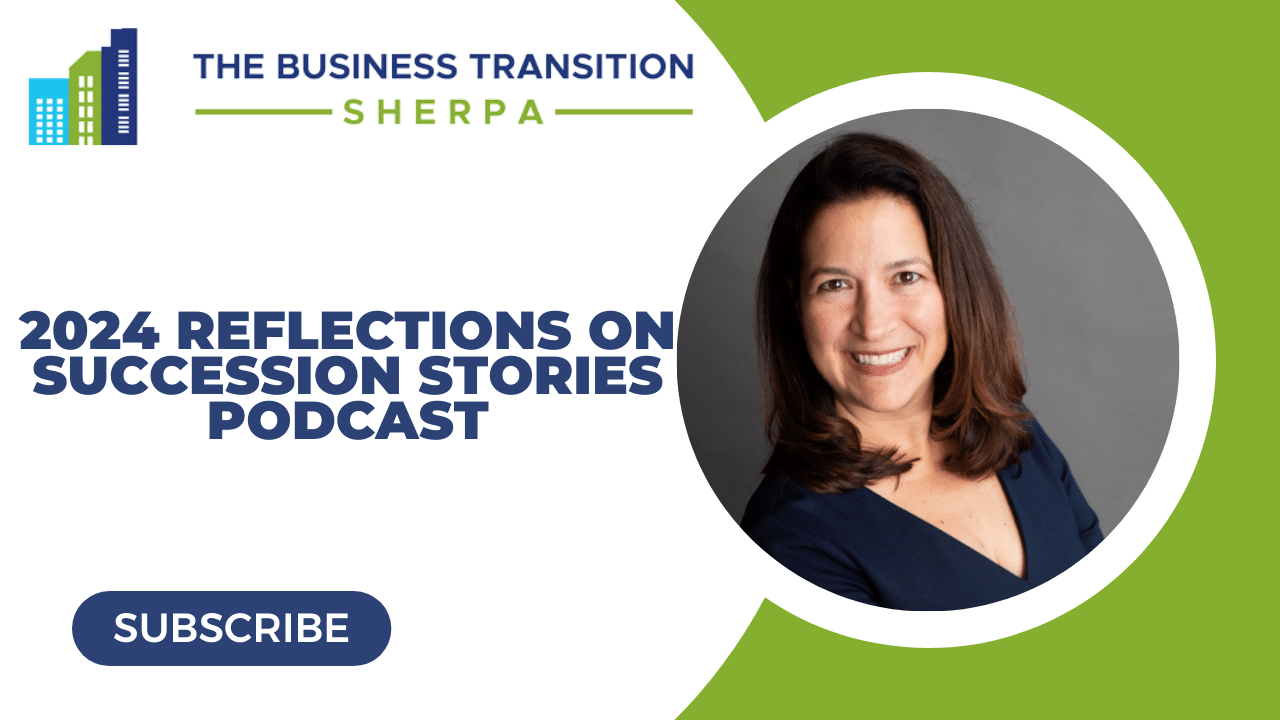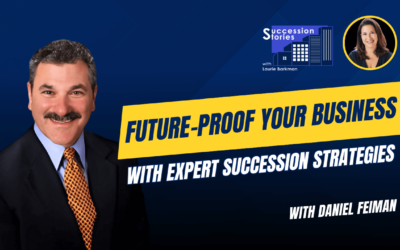Welcome to the Succession Stories podcast, where we delve into the intricate world of building a scalable business. Join host Laurie Barkman, The Business Transition Sherpa(™), and our guest Alex Neist, the visionary behind Hostage Tape, as we explore the transformative journey of entrepreneurship and legacy building. Under the umbrella of scalability, we uncover essential principles for business growth and development. Delve into the following key aspects: – What defines a scalable business? – Strategies for overcoming scalability challenges – The role of innovation and adaptability in scalability
NEW ONLINE MASTERCLASS:
“Endgame Entrepreneurship: Build With The Exit In Mind”
Join the waitlist: https://thebusinesstransitionsherpa.com/course/
***************************
Succession Stories host Laurie Barkman, The Business Transition Sherpa(™), welcomes Alex Neist, the visionary behind Hostage Tape, a health enhancement product that has evolved into an e-commerce powerhouse, generating seven figures in monthly revenue.
Before his entrepreneurial endeavors, Alex wasn’t just a businessman; he graced the field as a professional quarterback in the Arena football league. Off the field, he brought his expertise to coaching, amassing over 15 years in that arena.
Listen in as they explore the journey of creating a legacy company, understanding the founder-market fit, and discovering the nuances of building a brand around a commodity product. Alex will share insights on taking the leap into entrepreneurship, the meticulous process of developing a brand, and the secrets to making people remember you.
They also discuss the importance of niching down and how 16 years of experience, coupled with failures, has fueled Alex’s current successes.
Enjoy this Succession Stories episode about how to reverse engineer your business exit with Alex Neist.
Listen in to learn more about:
- Strategies for overcoming scalability challenges
- The role of innovation and adaptability in scalability
- The importance of niching down in entrepreneurship
- Finding the founder-market fit
Find Alex Neist here: https://www.hostagetape.com/
❤️ Show us the love: Submit a review for “Succession Stories” on Apple Podcasts or Spotify
***************************
Embark on a journey of understanding and practical application as we navigate the realms of building a scalable business, unveiling the potential for growth and empowerment. Unlock deeper insights into the transformative realm of entrepreneurship and scalability by engaging with us through various social media platforms:
My Links:
🌐 Website: https://TheBusinessTransitionSherpa.com
⏰️ Meet With Laurie: https://thebusinesstransitionsherpa.com/connect/
🎙 Podcast: https://podfollow.com/succession-stories
🎥 YouTube: https://www.youtube.com/@TheBusinessTransitionSherpa
😎 Instagram: https://www.instagram.com/lauriebarkman/
✖️ Twitter: https://twitter.com/LaurieBarkman
😺 TikTok: https://www.tiktok.com/@businesstransitionsherpa
📘 THE BUSINESS TRANSITION HANDBOOK:
Get a free PDF copy of “The Business Transition Handbook” by author Laurie Barkman:
OR text TRANSITION to +1-762-320-2826
Stay connected to our journey of exploration and discovery as we dive deep into the profound dynamics of building a scalable business, discussing strategies, challenges, and the essence of creating a lasting legacy.
Have I addressed your curiosity regarding how to build a scalable business and the transformative journey it entails?
Embark on a voyage of comprehension and transformation, diving deep into the strategies for creating a business scalable business, overcoming scalability challenges, legacy building, and the important role of innovation and adaptability in the scalability of your business.
SHOW TRANSCRIPT:
Laurie Barkman
Alex, it is so great to be with you on Succession Stories. Welcome!
Alex Neist
Thanks for having me. I appreciate it!
Laurie Barkman
We met in Columbus, Ohio not too long ago. You were the guy in the room with athletic tape on your nose and the t-shirt that you’re wearing right now, which is talking about your current company Hostage and the brand Hostage. You kind of stood out a little bit, I gotta say. You were somebody that I wanted to understand like, He’s clearly a walking billboard. There’s something going on here. There’s something cool. You did eventually get on stage and I learned more about your story. I had followed up with you and invited you to the show because it is a fascinating story and I’m excited to dive in.
Alex Neist
Awesome. It’s definitely like I’m always on brand. If there’s something that I’ve learned and always done in the 16, 17, 18 years of being an entrepreneur, I’m just always on brand. I’m always wearing what I’ve created. I don’t know if it’s because I love it and I’m trying to make a point or if it’s more that Steve Jobs mindset, I’m always gonna wear the same thing because then, it’s less I have to think about when I get up every day, because the shirt that you see me wearing, I wear the same shirt or variation, a different color of it. Every single day, even when my wife and I go on a date. I still wear it.
Laurie Barkman
It’s fairly recognizable and I’m gonna go with the branding and not OCD.
Alex Neist
We’ll go with that.
Laurie Barkman
We’re gonna go with that. But don’t you think there’s some element of brand identity that takes you back to your football days? You were a professional football player and you’re wearing that uniform, right? So you’ve been doing this a long time. Take us back to that time you were a professional athlete and the sport of football. Tell me about that.
Alex Neist
Football was my first love. It was the first thing that like, I’ll never forget when I was probably my son’s age, my son’s 14. It was probably around 13-14 years old and went to a birthday party. We’d all gotten these packs of Topps football cards. I got to the pack, I opened it up and I pulled out a Joe Montana card. Now, I’m dating myself here. This was way back in the late ’80s, early ’90s time when Joe Montana was huge. The 49ers were amazing. I pulled this card out and I didn’t know who he was but then all my friends were like, Oh my God, you got a Joe Montana card, like he’s the best quarterback in the league. Then something clicked and I just started practicing and practicing.
When I find something that I love, I’m very passionate about, which is probably why I’m a great entrepreneur, is that when I find something that I love, I love to play this game, whether it’s football, or it’s the game of business, then I just go all in on it. Went all in on football and then years later, I ended up becoming a professional. I played, I wanted to be the next Kurt Warner. If anybody in the audience knows who Kurt Warner was, Kurt Warner was a Hall of Famer. He was stocking shelves at High V and then he played arena football. Then from the Arena Football League went on and became the quarterback for the Rams, Super Bowls, MVPs Hall of Fame. He was like this Cinderella story that every young kid could look at and go, I want to do that, and didn’t happen. But I still played a number of years of arena football that really kind of helped develop these relationships and work ethic of how I needed to prepare day in and day out.
All the things I had to do just to become who I wanted to become. You’re competing every day, right? Like when you make it to this high level, nothing’s ever guaranteed, right? They’re always bringing in new guys to replace you. So it was just that level of competition that I thrived in. I loved preparing. Then from that foundation of sports, I took all those relationships where I learned and I said I’m gonna, I’m going to build a business. I built a business, my first business around sports. It was actually a sports video analytics company where we pioneered this concept of taking video and then chopping it up into pieces with data so that way then coaches could go in and search for any situation they want to be able to teach and coach their players more effectively. Nobody was doing this. Everybody was doing it manually by themselves and we actually pioneered the service of doing it for you. So now, all of these teams all these coaches who didn’t have huge staffs, like NFL teams did, college teams did.
They had a problem. Their problem was, how do I actually use this video and get anything out of it? And a lot of coaches were just, I guess the game was what it was, I pulled a few things out, and then we’ll let’s just move on. Because they felt like they would take more time to actually watch the video, analyze it, and do their homework. So we enable that new this whole new landscape of how teams and coaches could use their video now. Now, it’s the standard, this is what everybody does. Everybody has some sort of product or service that is actually chopping everything up and adding data to it so you can use it.
Laurie Barkman
Wow! I want to make sure I’m understanding. The target market was not the NFL because they have resources and it was not necessarily a big college teams, because they also have resources. Was it the smaller college teams and kind of a local sports team in our neighborhood, or who was the target?
Alex Neist
Ironically, we actually targeted college teams to start out with, but with a twist. What I recognized early on was as much as I loved football, I knew that there was a bigger competitor. At the time, when we started the first business, we bootstrapped it, it was a family business, and my brother and I did it. Usually, I would say don’t start a business with family but we did and it worked. It was what it was; you have your fights just because you have your egos and brothers want to fight. What we did was we realized that football was not the market, as crazy as it sounded, because that’s my love and that was what I knew really well. We recognize that there was another player in the space that had started when we started, who’d raised funding, gone that route of VC, and got really pretty big, but their core was football. We said, let’s acknowledge that there’s another part of the market here that they’re ignoring.
It’s pivoting and understanding a much bigger problem, and the bigger problem was that this competitor was ignoring Olympic sports. When I say Olympic sports, I mean, soccer, basketball, hockey, volleyball, all of the other team sports that maybe aren’t as popular in this sense, just the sheer amount of kids and the sheer amount of budget that gets allocated to football is really pretty much the most compared to all the others. He said, you’ve got a soccer team, for example, where they’ve got one coach many times and at the college level, maybe two, they’ve got a 90-minute match. How are they supposed to fo that? One coach is going to take 90 minutes, especially a soccer game, where it’s a full, the whole thing, 90 minutes of action? There’s a ton of video there that they need to then go in, analyze, break it down in chunks that they can use to teach the players and a lot of these even college coaches couldn’t do it. So we pivoted, and we said, this is the problem we need to solve. We actually went after college soccer and then we took off from there. Then we expand it into certainly small college, there was a period where we had almost every college national champion soccer team using us. But then we broadened into smaller college and then in high school and then club soccer and then went to volleyball and then hockey, in just all these sports. It just really blossomed from there. Everybody started to go holy smokes, look what these guys are doing, and then everybody else started to embrace this concept too.
Laurie Barkman
Gotcha. Yeah, I love it. You were zigging when they were zagging, and focused on a niche, expanded it eventually, but started with that niche of soccer. What was the business model?
Alex Neist
It was a SaaS. Basically, we would, it’s why I love EComm. Now, SaaS is really hard. It’s really hard. Like it’s like B2B SaaS, right? Because you’re selling athletic directors or selling coaches. You got to get them on a demo, do a sales call, essentially. Then you’re going through a traditional sales cycle, right? But we would basically sign people up for a year-long subscription. They would get signed up for, say, a $1500-$3,000 a year subscription that would cover all of their games that they could film and upload them, then we would break them down. There would be variations on whether or not we would do just their games or maybe would include Scout games that they would get from other teams and upload, or maybe we would do an entire league conference where everything was broken down so they could scan out anybody in the entire league at any point.
Laurie Barkman
Was this a software platform that was proprietary to your company?
Alex Neist
Yeah, so we wrote it, it was completely written in-house by us. The key there was it was a SaaS company, but it had a layer of service on it. So we had actual guys that were going in, watching the video, punching the keys, and then adding tags to it. It’s not like nowadays, there’s a lot of automation with AI that’s really starting to blossom. Essentially, we had human intelligence behind the keyboard, watching the video. It was a software as a service, with a service level added to it. That was what made us unique and very interesting to this whole new market.
Laurie Barkman
So your staff would tag and edit and put in the metadata on each clip by player number 36, or whatever that person’s name was so they could search that later and find the information. Find that specific clip later.
Alex Neist
It’s like waking up the next. Let’s say you played a soccer game last night, you wake up the next day, you go in and say I want to see every time Alex had a shot on goal. I want to see Elliot every time this team had a corner kick. I want to see every time Alex had a touch. Every time Alex had a Ford Pass. Imagine just Google searching it and that’s what you could do and pull up the video and you could watch those clips.
Laurie Barkman
That’s super useful for coaches, I would think and the value prop must have been there because you grew. How did you grow the business? You said you had a sales team.
Alex Neist
You’re looking at him,
Laurie Barkman
Okay, you were the sales team.
Alex Neist
But it was a lot of email and spamming, for years. I used to buy lists of coaches and then I would spam. This was in the early days of email marketing where you could get away with it. I would just buy these lists and then I would email the crap out of people and just send it to them.
The whole goal was to get people into the funnel to schedule a demo. When I say schedule a demo that means and so what’s funny is that in this age of Zoom, you know that we’re on and that we live in now, going through COVID and everything. We had been doing that for 10 years. So for 10 years prior to that, this was how we did things. Back then, we used GoToMeeting when booked GoToMeeting was popular along with WebEx and all that stuff, before Zoom exploded. We had to go to meetings with coaches and this was back when they couldn’t figure out how to pull the meeting up and they thought it was weird. They’re like, Can’t you just give me a call? I’m like, I need to show you my screens and we can go through it.
Laurie Barkman
Yeah, that’s funny, though. Kind of a throwback. And so your brother was what type of role with you in the business.
Alex Neist
He was the CTO so he wrote all the code. He did all the engineering. Then I was purely the business side where I was running the business; finances, sales, and marketing. From there, the team grew as it started to grow. We ran that for about 16 years and then in year 6, and we completely bootstrapped it. We didn’t raise any funding, I didn’t want to raise funding. I felt like if we didn’t need to, then don’t do it. What’s funny is my family has VC in it. So my sister was a partner at Kleiner Perkins for two decades.
Laurie Barkman
Not a small firm, pretty big firm.
Alex Neist
Very super well-known firm and she was there. She was always telling me if you don’t need to raise money, don’t. So we just didn’t. Plus, who knows? I think the whole idea of it being SaaS with a service component wasn’t interesting 10 years ago, they thought it wasn’t scalable. Whereas now, it’s very scalable, and it’s super interesting. I think we were just ahead of our time to truly raise funding in the way that maybe we could have nowadays. But, we bootstrapped it, and then 16 years later, we sold it, we sold it to a company in Tel Aviv.
Laurie Barkman
How did that come together? Did you put the company on the selling posts like hiring an intermediary in the process?
Alex Neist
I actually did it myself. I did on your broker to do this deal. But I acknowledged a couple of things in the market of shifting and one of them was this concept of just automated filming. There were a handful of companies that were developing camera technology that can automatically film games. I knew that this is where the future’s headed in sports and we’re not talking like NFL, we’re talking like most amateur sports, right? Most are below college football, but we’re talking college all the way down to amateur in all sports, being able to use a camera in some form that is just automatically filming the game that either you’re putting up or it’s installed in the venue. I knew that we needed to find a company that had that technology, and we needed to go either partner with them or get acquired by them.
I identified who the key players were in that space and then I just contacted them. I purposely found a couple of them to pit them against each other to create a market and then whittle it down. I negotiated the deal myself, which is if you’ve ever negotiated with an Israeli, they’re really good negotiators. That’s just their culture. Whereas I think in our culture in America, we don’t grow up being taught how to negotiate very well. That was a really good learning experience going through a multimillion-dollar negotiation with somebody who knew how to negotiate. It was great. We got through it, and got through our first exit.
Laurie Barkman
That’s exciting. Just to give a sense of size, how many employees were you at that time? After 16 years?
Alex Neist
Oh, boy. I think at that time, we were willing to spend like seven or eight people wasn’t okay. Huge, wasn’t that?
Laurie Barkman
I don’t know if you can share any specifics on revenue, or just ballpark.
Alex Neist
We were a seven-figure business. It wasn’t mind-blowingly huge like we’re getting with this business now. But it was a great learning experience. It was where it was my real-life learning of just all the things I failed and failed and failed and failed in so many areas, to get to where I am now. It was a necessary education.
Laurie Barkman
The terms of the deal, you said you negotiated it yourself, and it was your first time doing something like this. You can only imagine how stressful it must have been. Did you have different LOI, different offers to compare you said you picked one up to sort of take it to the next step? Was it an all-cash deal? Was it an asset sale? Was it an equity sale?
Alex Neist
We just had one LOI. I got two and I can pit them against each other, didn’t work out that way. It ended up working out that who we sold to, they gave us the loi, and then nobody else did. But when I evaluated them, I’m like, This just makes sense. Anyways, this company, the partnership that they had that was most attractive was they had their automated camera technology in half of the high schools around the country. They already had this framework, this foundation laid of all of their technology there and I’m like, this makes sense, this is like couldn’t be any perfect that we can just immediately inject ourselves into half the schools around the country, because they had the technology already there. It just kind of made sense.
The deal that we then negotiated was a it was an equity cash, very light on the cash. I think just because of how small we were, I didn’t have a ton of leverage to be able to truly negotiate like a ton of cash value. They gave us way more equity in the business than we got cash. Actually, the cash ended up just kind of paying a lot of debt that we had kind of accrued, any liabilities we had on the balance sheet. We had a ton of equity in this company that was just growing and growing and I still own some equity in the company. I had to vest two years, we signed the deal and then we moved over and then after those two years, I left and then I was able to raise the secondary or they raised a like a series-D or something like that. They rated the secondary on that which then we were able to sell some and I was able to sell some of that stock to then use to start this new venture.
Laurie Barkman
Just to rewind, you looked for a strategic fit, found it, and negotiated the deal. Then you were with the company for about two years, and then you left? Did you take some time off to think about what you wanted to do next?
Alex Neist
No, I didn’t. Because I look like any entrepreneur, unless you sell a company for eight figures, or nine figures, you’ve got a pretty decent-sized windfall to be able to just take your time but that wasn’t the case with this one. It was a relatively smaller exit that was really going to the value of it was going to happen years later with where this company is headed, and how, eventually, they’ll probably get acquired, and something’s going to happen with them at a fairly significant valuation. Knowing that, but also, any entrepreneur that goes through an exit, it usually never ends well. It was a very difficult time, the first year, it’s sunshine and rainbows and you go into it thinking like, you can actually make a difference but a lot of times, we learn that you can make a difference and they have their way that they want to do it.
As an entrepreneur, somebody who runs a business, you learn very fast that you can’t operate the same way. You can’t make all the decisions anymore, you can’t act like a cowboy, in a sense, and do the things you need to do and be able to work very fast, can’t work fast anymore. When you’re with a big company, things slow down to a grinding halt, and you get really frustrated. It was really frustrating, going into the second year to where I saw a writing on the wall that they really didn’t want me there. They just wanted to acquire the business, try to plug it in, try to learn everything out of me that they could on the team, and then after two years, get me to leave, because they wanted to know that they could control and call the shots rather than knowing that if I’m still there, they couldn’t.
It’s really hard to control an entrepreneur that ran his business. It’s no matter where he’s at. I think it was just very clear, alright, we gotta ride this ou so that we then we have everything we need, then he can leave, and then we know we’ve got full power. As frustrating as it was, I just knew midway between the second year that, it was time you were ready. I was ready and I knew that. I had to wait it out for that final year to get to pass the final vesting period and then, once I did that, then I exited.
Laurie Barkman
There’s probably a lot of emotion that you went through to leave, but you did have something contractual that held you there for two years, and then you said, Okay, I’m gonna do something different. Let’s talk about that. What did you decide to do?
Alex Neist
During that time of the final year, I kept thinking to myself, “What do I want to do? What am I going to do?” Because when I start something, I said it earlier that I do things I’m really passionate about, I’m a really passionate guy. I wanted to do something that I could really go all in on, and I didn’t know what it was yet. And I didn’t just want to pick something and think like, well, I can make a lot of money with this. Most of the time, that doesn’t work, right? You truly have to find something that you can wake up every single day, seven days a week, and feel amazing about and continue to put everything into it. I was going through a really difficult time in my personal life at the time, and it was through that difficulty. I was self-evaluating.
What did I need to do to improve as a man, improve as a husband, and improve as a just father, because I had two kids, and one of the things was my health. When you when you play sports your whole life and then you retire, you become a dad, you become a businessman, your health kind of takes a dive, right? My health took a dive in so I said maybe I need to figure out my sleep because I was snoring so bad that it sent my wife into the other room. Which is really part of the hole that I went through this difficult time that my wife and I had, because my snoring was so awful. It really became a catalyst in the relationship of where things kind of broke down. It was from there that I started to explore what do I got to do because most of us guys have issues with sleeping, or maybe we don’t know, we have issues with sleeping. We just don’t know whether it’s good or bad. A lot of snores as we get older. We don’t think anything of it but we really shouldn’t be snoring. It’s not good for you at all. Especially if it negatively impacts your relationship with your partner, it’s even worse. I thought, how do I improve my story and what do I do?
I went on Amazon, and I looked for like, anti-snoring things, and some of the things you see are these mouth guards that, you put them in and you burn your mouth, like hurt your jaw. And that didn’t work. But then the more that I dug into this concept and went down the rabbit hole, I discovered an article written by James Nester, and James Nestor wrote a best-selling book called Breath. If you haven’t read it, you gotta read it. Amazing book. He talks about this experiment where they went to Stanford Medical Center, and they plugged their nose for 10 days. They were going to record both with the doctors as well as anecdotally how they felt. When they did that, they developed sleep apnea, snoring, and really dangerously low levels of blood oxygen. After 10 days, they unplugged their nose, they took their mouth shut, and everything went away in a day or two.
Laurie Barkman
Wow, that’s incredible!
Alex Neist
It was at that moment that I went, “Whoa, so you mean to tell me that this is mouth breathing? This is a mouth-breathing issue.” And I thought, How have I been a high-level athlete my whole life and our coaches have never taught us this. They never taught us the importance of keeping their mouth shut and breathing through our nose. It seems to be this concept that’s been lost in Western civilization here and I don’t know why. I’m just not sure why. Even James talks about it, he doesn’t really know why it’s lost either but it just isn’t something that we really talk about anymore.
Now, it’s starting to become a topic that a lot of people are becoming more aware of, especially with companies like me who spend as much money as I do, marketing about it. I thought, wow, there’s a business here. There’s a business around this concept because I went on Amazon and I bought some just cheap mouth tape, right? You do it for the first time. You don’t know what to get, you don’t know how to use it. You don’t know what to get so I just bought something. I put it on when I woke up the next day. I felt like a teenager when I woke up. I felt like I had so much energy and I couldn’t believe that holy crap, this worked. Keep in mind that I was anxious, putting the tape on and going to sleep. It’s a normal reaction that everybody has of wait a minute, putting tape over your mouth, are you going to die? What if your nose gets clogged? Are you just going to not wake up? But I did it and got through it. Woke up, felt amazing. That was when I realized that. I can take this product and I can create an amazing brand around it. I’ll never forget, I think it was boys Ali Moyes. Ali was the founder of native deodorant and he had said something that resonated with me where you can take any commodity and create an amazing brand around it, and then you’ve got a good business. I figured, we’ve got tape, it’s a commodity and if we create a really cool, amazing, unique brand around it, then we’ve got something there. I took cues from Liquid Death. Liquid death is this amazing water company that’s all the rage right now and you know, in the business world of what they’ve done how they’ve done it, and it’s just they flip marketing on its head.
Laurie Barkman
Sometimes those little blurb or bluebirds do come a calling when you least expect but what I always like to say on this show and with my clients is, if your company is ready to sell at any time, that’s the best situation. Because if you sell, like you said, at a great price, that’s a win. And if you don’t, and you continue to have good financials, good growth potential, and it’s fun, then that’s a win too, as you said, it’s the best of both worlds.
Alex Neist
Well, I think it’s interesting is like when you reverse engineer the cell, you go who would buy us? Then you go, once we get past 500 million to a billion, there’s not that many who could afford to buy us other than the really big CPG companies. So you kind of look at them and go, I guess those are ones who could buy us. But then below that there’s probably private equity and I feel really good knowing that. After this year, for the next couple of years, we’re going to be extremely attractive for private equity to want to scoop us up, but I just don’t know that. I’m not going to sell it for eight figures.
Laurie Barkman
No, you’re building a billion-dollar brand, as you said, and you’re also in the other conversation, talking about potential legacy with your family, and then maybe one day, your son might come into the company. The future is yours and what you make of it, I think you talked about product market fit, what I keep thinking about is founder market fit and your story just has all those elements of why. Why you chose this product, why it’s important to you the mission that you’re on. That’s super important. If you are going for money from an investor, they’re going to look for that, and you’re not at your bootstraps which is incredible. But at some point, there’s going to be that situation where you’re looking for the fit with the exit, and I’m sure you’ll find it, whatever it is, I’m grateful to have you on the early side of your story. I know one day you’ll come back and we’ll talk about the next side of your story. I want to shift to kind of a mic-drop question. I know you got so many lessons learned and share maybe one or two. What are the top two things that you would say to an entrepreneur who’s going through their journey to build their business, grow their business? What are the two things that you’ve learned along the way?
Alex Neist
I think one of the biggest things is you have to be okay to fail. You have to fail. To get better, you got to be okay with that you have to be able to confront failure in the face and understand that it’s these difficult challenges that helped shape you to become this stronger, better, more amazing entrepreneur. Because if you don’t have those failures, you can’t learn, you can’t get better. At the moment when it’s happening, rather than thinking, woe is me, oh my god, nothing’s going right. You have to shift. It’s like what Tony Robbins always said, you shift your mind to degrees. Just that small degree of separation completely changes the trajectory of what can happen, and you shift it and you think. This is all happening to make me better. It’s all happening to make me stronger. What am I going to learn from this? How am I going to react? Where am I going to go with this? That’s one of the biggest things. I think another thing is something that I tell my kids all the time that I learned was, you can accomplish anything you want. You just kind of work really hard for it.
Laurie Barkman
Those are great messages. Really powerful. I learned that your mom.
Alex Neist
My mom is an amazing woman. Both my mom and my dad are amazing, amazing parents. My dad was a self-made doctor. When he was in high school, they didn’t have any money and he knew in order to get to college, he had to get a scholarship. So he got a scholarship, went to medical school, and then created his own practice and everything. He was the example of doing; I’ve watched him do it. But my mom, she was validating us as kids. She was using her words to say, “Hey, you can do anything you want. You just got to work for it. You can do it.”
She was always the one telling us while then we were watching my dad actually do it. I think that’s something too is as too many of our kids and young kids these days, they don’t get that from their parents or parents right now aren’t maybe doing as good of a job telling their kids like in a constructive way, right? Obviously, you don’t want to give them a false sense of “You could do anything you want.” But you actually can do anything you want. You just have to be willing to do what it takes to get to that point.
Laurie Barkman
Your advice from both parents and seeing them in action is a perfect blend of what you’re talking about. It’s having the confidence, having the vision, and also rolling up your sleeves and doing it and you’re absolutely doing that. Alex, do you have a favorite quote about entrepreneurship or leadership? Something that you can share with me?
Alex Neist
I think it’s the second thing I said, that’s one of my favorite quotes that I say is “You can do anything you want. You just gotta work hard for it.”
Laurie Barkman
There you go. Alex, if people want to learn more about you connect, learn more about the product, about Hostage Tape, what’s the good way for them to do that?
Alex Neist
Yes, so don’t let bad sleep hold you hostage, go to hostagetape.com and then you can go to any of our social handles, which is just Hostage Tape.
Laurie Barkman
Perfect. Alex, thank you so much for this conversation. I learned a ton by talking with you. It’s great to meet you in person. I’m sure we’ll meet again at some point and I’ll be watching and cheering for you and the brand all along the way.
Alex Neist
Awesome. Well, thanks. Appreciate it. Great being here.
Laurie Barkman
To the listeners, be sure to hit subscribe so you don’t miss a future episode. And if you listen and love the podcast, enjoy! Do me a favor leave me a rating and review on Apple or Spotify. It enables us to reach more people and help them along the way. For show notes and more information about Succession Stories go to successionstories.com. Tune in next time for more insights from transition to transaction.







